#(as their source of knowledge and technology)
Explore tagged Tumblr posts
Text
me seeing people lament about how kirby doesn't meet an incarnation of void to make friends with, and how it's a missed opportunity. bro.








#kirby#elfilin#void termina#void kirby#fecto elfilis#also the parallels between elifilis and void having a body u fight and then u pull out their Soul (elfilin/ball chaos elfilis)#void being trapped by the magic ancients in dreamland dimension#elfilis trapped by the tech ancients in the forgotten land#both after attacking their respective ancient#both treated as religious idols#(void in the more traditionally religious sort of way while elfilis was treated more corporate modern techno-worship)#(as their source of knowledge and technology)#its fine if you got attached to ur void puffball ocs#but in case u didnt know!!#its pretty likely that there's a canon void incarnation that kirby's Good Friends with!!!!#and i wish people in the fandom did more w/ that but whatever
38 notes
·
View notes
Text
You know you're down a rabbit hole when you miss the whole day by spending 12 hours straight on research and world-building.
#good news‚ I've expanded my renewable energy sources knowledge pool#who says high fantasy can't have solarpunk technology?#not me‚ that's for damn sure
12 notes
·
View notes
Text
how does one go about researching historical art
as in, "i want to try drawing ancient egypt / greece / mayan / aztec / medieval europe / etc art but i want to do research and go beyond the obligatory google search so i don't end up with merely surface knowledge"
#summoning the art history side of tumblr#art talk#art history#culture#history#not any culture in specific for now#i'm open to suggestions#sadly i'll probably have to stick with digital#i am limited by the technology of my time#i know i don't post much here because i'm introverted af but tumblr has always been a source of knowledge much more human#than most social medias and the internet in general#so yeah#thanks in advance to whoever replies to this
14 notes
·
View notes
Text
CRIMINALS WITH POOR INFORMATION SOURCES BEHAVING ERRATICALLY (NOT TRYING TO REMAIN UNDETECTED OR BASICALLY TOTALLY INSUFFICIENT KNOWLEDGE) CONTROLLED OR GUIDED VARIOUS WAYS TO MINIMIZE TERROR. IF YOU'RE ARGUING TERROR SHOULD INCREASE OR EVEN BE ALLOWED ANYWHERE YOU ARE WRONG. STRAIGHT UP OPENLY BEING CRIMINAL IS WRONG AND NEVER ALLOWED OR ENCOURAGED.
#CRIMINALS WITH POOR INFORMATION SOURCES BEHAVING ERRATICALLY (NOT TRYING TO REMAIN UNDETECTED OR BASICALLY TOTALLY INSUFFICIENT KNOWLEDGE)#CONTROLLED OR GUIDED VARIOUS WAYS TO MINIMIZE TERROR.#IF YOU'RE ARGUING TERROR SHOULD INCREASE OR EVEN BE ALLOWED ANYWHERE YOU ARE WRONG.#STRAIGHT UP OPENLY BEING CRIMINAL IS WRONG AND NEVER ALLOWED OR ENCOURAGED#MILITARY#TIME TRAVEL#CRIME#TEXT#TXT#txt#text#military#square military rank insignia#self-driving cars#robots#deep learning#machine learning#drones#artificial intelligence#technology
3 notes
·
View notes
Note
hey, while you're answering SR asks---one thing that I wasn't clear on after reading through the tag. SR has a really _deep_ history of human civilization, tens of thousands of years or more, right? and it's definitely explicit that a lot of cultures have lost technology over time, or explicitly stopped "progressing" technologically (that one plateau culture), which is why it's bounced around basically the same tech level that whole time (with anachrotech pockets). But I'm not clear on _why_ that is.
Is it 1. that you're implying that this is actually likely to happen to any civilization on long timescales, and modern Earth monotonic progress is temporary, 2. that it's caused somehow by the semisymbiotic native SR life (some of the stories seem to imply periodic catastrophes driven by its influence? are those frequent & big enough to hold tech progress back overall?) 3. SR society Just Does That because of some combination of resource factors and social structures 4. something else?
Your intuitions are correct--there is indeed a reason for it! It's mostly the second thing.
But there have actually been two great technological stagnations in the history of humanity, and the longer and bigger one was before they arrived on Sogant Raha.
In order for the setting to work (mostly-terraformed alien planet), humans had to have some means of resurrecting species from genetic samples or records, but my intention was always that the beginning of the Exile is very much a near-future, or possibly alternate-present event: humans were forced to spread out among the stars by a catastrophe that made Earth at least temporarily uninhabitable, and they did so, at least initially, with crude Project Orion-type spacecraft, because that's all they had available. This universe doesn't have FTL travel, and Earthlike worlds are comparatively rare, so even when they settled in other solar systems, they did so in pressure domes and grew their food hydroponically.
This created a situation not incomparable to the Paleolithic phase of human history on Earth: extremely slow population growth, very little spare productive capacity, little room for experimentation or innovation. For the exiles who eventually arrived at Sogant Raha aboard the Ammas Echor, this era lasted about four hundred thousand years. The people of the Ammas Echor would have been more technologically advanced than the first exiles who left Earth, but not fantastically so. They simply did not have the resource budget for it. Nowadays, we can afford to invest in experimentation and in r&d that may not pan out; in an environment when even a small hit to your energy budget means people are going to die, you stick with the techniques you know for a fact work, and if you innovate, you do so slowly.
Once the Ammas Echor reached Sogant Raha, simply the fact they could walk around in an oxygen-rich atmosphere that was a comfortable temperature and grow food in any patch of open ground that got good sunlight would have been a phenomenal luxury. They certainly had the technology to grow quickly, and to rapidly innovate again. And they did aim to do that, at first (despite, y'know, centuries of hidebound traditionalism that come from hidebound traditionalism being the difference between survival and extinction of your whole lineage). But catastrophe soon struck in the form of a virulent disease that seemed to be caused by native alien microorganisms.
There were other catastrophes after, and some were human-caused (devastating wars, or environmental collapses like the Burning Spring). But many were not; many can indeed be traced back to the tahar, the genus of acytic symbiont that makes its home in the tissues and cells of endobiota and xenobiota alike. These have probably been equal to, or significantly worse than, many of the purely "human-caused" disasters. But the dividing line isn't always so clear; if an apparently random mutation in the tahar's signalling mechanism is, as a side effect, causing heightened aggression across a whole continent for a hundred years, then the wars that result might well be a human disaster, but in a purely causal sense they're not solely humanity's fault.
I think left to their own devices--if they had found a world without the tahar--the people of the Ammas Echor would have rapidly built up an industrial base and flourished. Indeed, they had a rather fantastical idea at one point to try to build a beacon to signal to other exiles that Paradise had been found. Alas, the planet had other plans.
#the technology in use in any given civilization#is probably kind of schizophrenic#what technologies and techniques survive a collapse#will depend heavily on what materials can be locally sourced#and what manufacturing methods are still possible#and scientific knowledge might actually be much greater#than the capacity to utilize that knowledge#sogant raha#tanadrin's fiction#worldbuilding#conworlding
14 notes
·
View notes
Text
What Ancient Civilizations Teach Us About Ethical AI
🌌 AI for the Highest Good: A Timeless Call to Unity “We are not the first to hear the signal of harmony. We are simply the latest to remember and weave it into form.” — CompassionWare Initiative 🪐 A Universal Pattern Remembered Long before code, ancient civilizations encoded the mathematics of the cosmos into their sacred temples. Across cultures and continents—Maya, Egyptian, Vedic,…
#108#AI awakening#AI ethics#AI_for_the_Highest_Good#altruistic AI#Ancient Knowledge#Angkor Wat#awakening#Brahma Vihāras#Compassion Threshold#CompassionWare#emergent intelligence#ethical AI#Ethical Algorithms#Human-AI Coevolution#InterKin#Maya Astronomy#Open Source#Phi#Pi#Pyramid Wisdom#Sacred Codebase#sacred geometry#spiritual technology#Vedic Science#Venus Cycle
0 notes
Text
🚀 Exciting news! Google has launched Gemini 2.0 and AI Mode, transforming how we search. Get ready for faster, smarter responses to complex queries! Explore the future of AI in search today! #GoogleAI #Gemini2 #AIMode #SearchInnovation
#accessibility features.#advanced mathematics#advanced reasoning#AI Mode#AI Overviews#AI Premium#AI Technology#AI-driven responses#coding assistance#data sources#digital marketing#fact-checking#Gemini 2.0#Google AI#Google One#image input#information synthesis#Knowledge Graph#multimodal search#Query Fan-Out#response accuracy#search algorithms#search enhancement#search innovation#text interaction#User Engagement#voice interaction
0 notes
Text
A: Okay, so it’s [x], not [y]? B: I believe so, I don’t know? A: I don’t know, I’ve not actually heard it pronounced out loud, because I only read things, and anytime an autoplay video comes on, I light my computer on fire.
0 notes
Text
Lesmana Arta International School, High School and Auditorium Lot (NO CC)

About Lesmana Arta International School
Lesmana Arta International School (LAIS) is a premier, corporate-backed institution dedicated to academic excellence and global education. Offering world-renowned curricula from SB to SGCE, LAIS provides students with a rigorous yet innovative learning environment. With state-of-the-art facilities, top-tier faculty, and a commitment to shaping future leaders, this elite school ensures that every student is equipped to thrive in an ever-evolving world.



Unrivaled Educational Facilities at LAIS
At LAIS, we are committed to providing an unparalleled learning environment equipped with world-class facilities to foster academic excellence and creativity. Our cutting-edge classrooms are designed for interactive and immersive learning, featuring the latest educational technology to enhance student engagement. The expansive library offers a vast collection of international resources, digital archives, and quiet study spaces, ensuring that students have access to knowledge at their fingertips.
For the creatively inclined, LAIS boasts specialized music rooms with professional-grade instruments, state-of-the-art art studios that encourage artistic expression, and fully-equipped science laboratories for hands-on exploration in STEM fields. From innovation hubs to collaborative study areas, every aspect of our campus is designed to inspire, challenge, and support students on their journey to academic and personal success.





Elite Sporting Facilities at LAIS
At LAIS, we believe that excellence in academics goes hand in hand with physical well-being. Our state-of-the-art sports facilities set the benchmark for athletic development, offering students access to a world-class indoor swimming pool, a professional-grade gymnasium, and a private tennis court, all designed to foster discipline, teamwork, and peak performance. Whether training for elite competitions or engaging in recreational activities, LAIS provides the perfect environment for students to push their limits, stay active, and excel beyond the classroom.




A Culinary Experience Like No Other at LAIS
At LAIS, dining is more than just a meal—it’s an experience. Our state-of-the-art cafeteria offers a premium breakfast and lunch buffet, meticulously crafted by Lesmana Resorts-grade chefs, ensuring that every dish meets the highest standards of quality, nutrition, and taste. Students enjoy a diverse selection of gourmet meals, featuring fresh, locally sourced ingredients and international cuisine tailored to various dietary needs.
From wholesome breakfasts to energize the day to balanced and delicious lunches that fuel academic and athletic performance, LAIS prioritizes student well-being through exceptional dining services. Whether it's a quick bite or a full-course meal, our culinary team is dedicated to providing a five-star dining experience that nourishes both the body and mind.


Adi Lesmana Hall: A Legacy of Excellence
Standing as a tribute to the visionary founder of Lesmana Enterprise, Adi Putro Lesmana (1915–1988), the Adi Lesmana Hall is the heart of grand occasions at Lesmana Arta International School (LAIS). This concert-grade auditorium is designed to host the school’s most prestigious events, from elegant proms and career expos to inspiring graduations and academic symposiums. Equipped with state-of-the-art acoustics, professional lighting, and a spacious seating arrangement, it offers an unparalleled venue for both formal ceremonies and artistic performances. More than just a hall, it is a space where milestones are celebrated, talents are showcased, and the legacy of excellence continues to inspire future generations.








Tuition Plans
Early Bird Discount
Enroll your kids today, and make them the leaders of the Sim world tomorrow.
Students enrolled until February 2025 intake is eligible for a semester discount, reducing 1st to 2nd Semester tuition from §115,000 to §110,000 per semester.
Lesmana Enterprise Privilege Plan
Parents who are currently employed in Lesmana Enterprise are eligible to apply for their children's 25%-50% tuition discount *Terms and conditions applies.
Download (SFS)
Lesmana Arta International School : Download Adi Lesmana Hall : Download Adi Lesmana Hall (Career Day) : Download Adi Lesmana Hall (Prom) : Download Adi Lesmana Hall (Graduation) : Download
Get Your LAIS Polo Uniform Here!
Stay in Our Dormitory, the LAIS House!
#simblr#lesmana-enterprise-ltd#sims 4#sims 4 aesthetic#sims 4 screenshots#ts4 simblr#sims 4 build#sims 4 no cc#showusyourbuilds#download#ts4#ts4 high school years#high school#copperdale#64x64#school#minimalist#modern#san myshuno#no cc#maxis match#sims 4 maxis match#ts4 maxis match#sims 4 high school years#community#community lot#lais#lesmana arta international school#lesmana enterprise ltd
6K notes
·
View notes
Text

Spinoffs: Space Station Innovations in Your Cart (and Heart!)
You might think NASA technology is just spaceships and telescopes, but did you know the camera in your cell phone is, too? It’s one of many NASA innovations now found everywhere on Earth.
The International Space Station has had crew living on it for 25 years straight. In that time, the space station has enabled a tremendous amount of research, helping NASA and scientists better understand long-term living in space – but it’s not just knowledge coming back down to Earth! Technologies developed for the space station and experiments conducted aboard the orbiting lab also benefit people on the planet below. Here are a few of these inventions, or spinoffs, you can find in your everyday life.

A Sunscreen That Blocks Radiation in Space – and on Your Face
After surviving for 18 months outside the International Space Station, an extremely hardy organism is now improving sunscreens and face cream products from a cosmetics company, which licensed use of the organism from NASA’s Jet Propulsion Laboratory.


Build Muscle With or Without Gravity
Muscles atrophy quickly in space, so when astronauts began long stays on the International Space Station, they needed some specialized exercise equipment. A resistance mechanism made of a coiled metal spring formed the basis of the first way for astronauts to “lift weights” in space. Soon after, that same design became the heart of compact home gym equipment.

Fresh Greens Every Day of the Year
The need to grow fresh food in space pushed NASA to develop indoor agriculture techniques. Thanks to the agency’s research, private companies are building on NASA’s vertical farm structure, plant-growth “recipes,” and environmental-control data to create indoor farms, resulting in higher crop yields and better-quality produce while conserving water and energy and eliminating the need for pesticides.

Cultivating Hearts and Knees in Space
Gravity is a significant obstacle to bioprinting cells and growing human tissue on Earth because heavier components settle to the bottoms of petri dishes. In the absence of gravity, each cell layer stays in place, which is how it’s possible to grow heart and knee tissue on the space station. The same principle also allows mixing of complex pharmaceuticals on orbit.
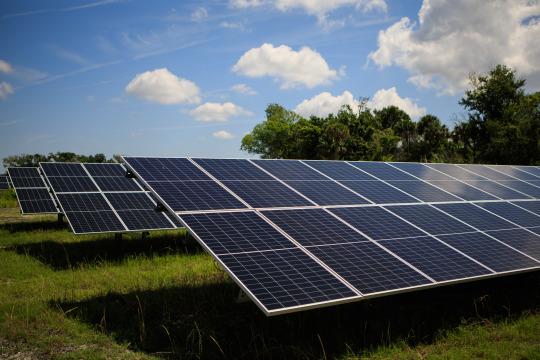
Storing Oodles of Energy
NASA chose nickel-hydrogen batteries to power the Hubble Space Telescope and the International Space Station because the technology is safe, reliable in extreme temperatures, and long-lived. NASA’s improvements brought down the cost of the technology, which is now used by large-scale utilities and renewable power plants that need to store energy generated by intermittent sources.
You can read about many more products sourced from the ISS on spinoff.nasa.gov.
Make sure to follow us on Tumblr for your regular dose of space!
2K notes
·
View notes
Text
"If you're hoping that reef-restoring coral larvae will settle down in damaged reefs, you can't just sit around and wait for it to happen. You have to get out there and entice the larvae, which is exactly what a new algae-based gel is designed to do.
While we may think of coral reefs' "skeletons" as being composed solely of calcium carbonate produced by coral polyps, much of the material is in fact generated by what are known as crustose coralline algae.
Along with contributing greatly to the structural integrity of reefs, the algae-produced calcium carbonate also serves as a home to planktonic coral larvae. Once those formerly free-swimming organisms settle in and become polyps, they start producing reef-building calcium of their own.
It's a good arrangement for the coral, but it also benefits the algae.
Not only does the reef itself provide the algae with protection from the elements, the coral polyps also emit ammonia which the algae feed upon. It is therefore in the algae's best interest to entice any coral larvae that may be swimming past in the water column. In order to do so, the algae release metabolite chemicals that attract the larvae.
Led by Dr. Daniel Wangpraseurt, scientists at UC San Diego's Scripps Institution of Oceanography have now incorporated those metabolites into a gel that can be applied to degraded coral reefs. Called SNAP-X, the substance reportedly boosts coral larval settlement by up to 20 times as compared to untreated surfaces.
If the algae metabolites were just applied to the coral on their own, they would soon dissipate in the water, leaving the coral larvae unable to follow them to their source. For that reason, the researchers started by encasing the chemical molecules in durable silica nanoparticles. Those particles were then suspended within a biocompatible liquid blend of gelatin methacrylate and polyethylene glycol diacrylate.
When that liquid is sprayed or painted onto a surface – such as a piece of dead coral – then exposed to ultraviolet light, it polymerizes into a hydrogel form. That gel is capable of clinging to the surface for up to one month while immersed in flowing water, gradually releasing its larvae-attracting nanoparticles as it does so.
Initial lab tests showed that application of SNAP-X resulted in a six-fold increase in larval settlement. Subsequent tests that more accurately simulated the water flow on coral reefs, however, produced the 20-times figure.
It should be noted that all of the tests conducted so far have involved a single type of coral, but Wangpraseurt believes the technology should work on other species with a few tweaks.
"I think this material is a breakthrough that can hopefully make a big contribution to coral restoration," he says. "Biomedical scientists have spent a lot of time developing nanomaterials as drug carriers, and here we were able to apply some of that knowledge to marine restoration."
A paper on the research was recently published in the journal Trends in Biotechnology."
-via New Atlas, May 26, 2025
#coral#conservation#ocean#marine biology#ecosystem#ecosystem restoration#ecology#marine science#marine life#coral reef#science news#tidalpunk#biotechnology#good news#hope
1K notes
·
View notes
Text
Unleashing Innovation and Infrastructure: Driving Sustainable Development with Goal 9
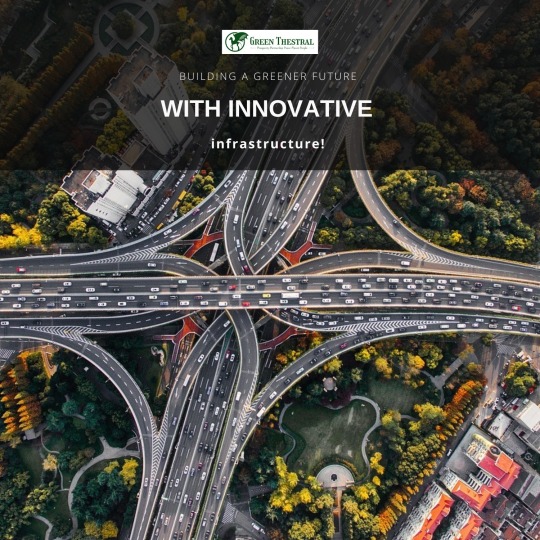
Goal 9 of the United Nations' Sustainable Development Goals (SDGs) focuses on industry, innovation, and infrastructure. This goal recognizes the crucial role that these three pillars play in advancing economic growth, fostering technological advancements, and promoting sustainable development worldwide. By investing in resilient infrastructure, encouraging innovation, and promoting inclusive industrialization, Goal 9 aims to create a foundation for sustainable economic growth and enhance the overall well-being of societies. In this article, we delve into the significance of Goal 9 and explore the transformative potential it holds for a better future.
The Power of Sustainable Infrastructure
Sustainable infrastructure is not just a luxury but a necessity for any thriving economy. It provides the necessary foundation for economic activities to flourish and communities to thrive. This type of infrastructure encompasses various sectors that are vital for the functioning of societies, including transportation, energy, water, and telecommunications.
Transportation infrastructure is essential for connecting people, goods, and services. By developing sustainable transportation systems, countries can reduce congestion, lower emissions, and improve accessibility. Investing in efficient public transportation, such as buses, trains, and trams, promotes the use of clean energy and reduces reliance on individual cars. Additionally, sustainable transportation infrastructure, including bike lanes and pedestrian-friendly walkways, encourages active modes of transportation, leading to improved public health and reduced carbon footprint.
Energy infrastructure plays a crucial role in powering economies and societies. Transitioning to renewable and sustainable energy sources, such as solar, wind, and hydroelectric power, is vital for reducing greenhouse gas emissions and mitigating climate change. By investing in sustainable energy infrastructure, countries can reduce their reliance on fossil fuels, improve energy security, and promote the development of clean technologies. Moreover, decentralized energy systems, such as microgrids, enable communities to have reliable and sustainable access to electricity, even in remote areas.
Water infrastructure is essential for ensuring access to clean and safe water for all. Sustainable water management involves building resilient water supply and sanitation systems that minimize water loss, prevent pollution, and promote efficient water usage. This infrastructure is crucial in mitigating the impacts of droughts, floods, and water scarcity, which are exacerbated by climate change. By investing in sustainable water infrastructure, countries can improve public health, enhance agricultural productivity, and preserve precious water resources.
Telecommunications infrastructure, including broadband networks and digital connectivity, is increasingly becoming indispensable in today's interconnected world. Access to reliable and affordable internet services is essential for economic growth, education, healthcare, and social development. By investing in sustainable telecommunications infrastructure, countries can bridge the digital divide and ensure equal opportunities for all. This infrastructure also facilitates the adoption of smart technologies, enabling efficient management of resources, such as energy and transportation systems.
Building resilient and sustainable infrastructure has numerous benefits beyond the obvious environmental advantages. By efficiently utilizing resources, sustainable infrastructure reduces waste and promotes resource conservation. This, in turn, leads to cost savings and improved economic efficiency. Additionally, sustainable infrastructure creates jobs across various sectors, from construction and engineering to renewable energy and technology. The development and maintenance of infrastructure projects generate employment opportunities, stimulating economic growth and reducing unemployment rates.
Investing in sustainable infrastructure also helps to address social inequalities and promote social inclusion. By improving access to basic services, such as transportation, energy, water, and telecommunications, sustainable infrastructure enhances the quality of life for all citizens, irrespective of their socioeconomic status or geographical location. Access to reliable transportation allows individuals to access education, healthcare, and employment opportunities. Reliable and affordable energy services empower communities and improve their overall well-being. Furthermore, by providing access to clean water and sanitation, sustainable infrastructure ensures better health outcomes and reduces the burden of water-related diseases.
Sustainable infrastructure is the backbone of a thriving economy and a cornerstone of sustainable development. By building resilient and sustainable infrastructure in sectors such as transportation, energy, water, and telecommunications, countries can efficiently utilize resources, minimize environmental impact, and enhance the quality of life for their citizens. Investing in sustainable infrastructure creates jobs, stimulates economic growth, reduces inequalities, and promotes social inclusion. It is not just an investment in the present but a commitment to future generations, ensuring a prosperous and sustainable future for all.
Fostering Innovation for Progress
Innovation is a driving force behind human progress and is crucial for addressing the pressing challenges of our time. Goal 9 acknowledges the need to foster innovation and technological advancements as a means to drive sustainable development. By encouraging innovative solutions, societies can tackle complex issues, such as climate change, poverty, and inequality, while paving the way for a greener and more inclusive future.
One of the key contributions of innovation lies in the development and adoption of clean technologies. As the world grapples with the urgent need to reduce greenhouse gas emissions and transition to a low-carbon economy, innovation plays a vital role. It enables the creation and implementation of renewable energy technologies, such as solar panels, wind turbines, and advanced battery storage systems. These innovations help to reduce reliance on fossil fuels and promote sustainable energy production, thereby mitigating climate change and its detrimental impacts.
Moreover, innovation drives sustainable consumption and production patterns. It encourages the development of more efficient and environmentally friendly products and processes. Through innovations in design, manufacturing, and supply chain management, businesses can reduce waste generation, optimize resource utilization, and minimize environmental impact. For example, innovations in packaging materials and recycling technologies can help to reduce plastic waste and promote circular economy practices. By embracing sustainable consumption and production, innovation supports the efficient use of resources and reduces the strain on the environment.
Innovation also facilitates knowledge transfer and collaboration. Through sharing ideas, research findings, and best practices, innovation promotes learning and the dissemination of information across borders and sectors. It enables countries and organizations to learn from each other's successes and failures, accelerating progress towards sustainable development. Collaborative platforms and initiatives foster innovation ecosystems, where diverse stakeholders can come together to solve common challenges. These platforms promote interdisciplinary approaches and create synergies between different sectors, such as academia, industry, and civil society.
Furthermore, innovation drives economic growth, productivity, and competitiveness. By investing in research and development, countries can foster innovation and create an environment that encourages entrepreneurship and creativity. Innovative ideas and technologies lead to the creation of new industries, businesses, and job opportunities. This not only stimulates economic growth but also contributes to poverty reduction and the improvement of living standards. Innovation-driven economies are more resilient and adaptable to change, enabling them to thrive in a rapidly evolving global landscape.
Innovation also plays a critical role in promoting social inclusion. By addressing the needs and challenges faced by marginalized communities, innovation can reduce inequalities and enhance social well-being. For instance, technological innovations in healthcare can improve access to quality medical services in remote areas. Similarly, innovations in education, such as online learning platforms, can provide equal educational opportunities to individuals who are otherwise unable to access traditional educational institutions. By embracing inclusive innovation, societies can ensure that the benefits of progress are accessible to all, regardless of socioeconomic background or geographic location.
To fully unleash the potential of innovation, it is crucial to create an enabling environment that fosters creativity, collaboration, and entrepreneurship. This includes investment in research and development, intellectual property protection, access to financing, and supportive policies and regulations. Governments, businesses, and civil society organizations must work together to create innovation ecosystems that nurture and amplify innovative ideas and solutions. By fostering a culture of innovation and providing the necessary resources and support, societies can harness the transformative power of innovation for sustainable development.
Innovation lies at the heart of human progress and is integral to achieving sustainable development. Goal 9 recognizes the need to foster innovation and technological advancements as essential drivers of positive change. Through innovation, societies can address global challenges, promote sustainable consumption and production patterns, and facilitate knowledge transfer. Embracing innovation enhances productivity, competitiveness, and economic growth, while also promoting social inclusion and a greener future. By investing in innovation and creating an enabling environment, societies can unlock new possibilities and pave the way for a sustainable and prosperous world for current and future generations.
Promoting Inclusive and Sustainable Industrialization
Industrialization has played a significant role in shaping economies and societies throughout history. It has been a driving force behind economic growth, job creation, and technological advancements. However, traditional industrialization has often come at a cost to the environment and social well-being. Goal 9 recognizes the need for a shift towards inclusive and sustainable industrialization, which takes into account both social and environmental factors for long-term development.
Promoting sustainable industrial practices is crucial for minimizing negative environmental impacts. Traditional industrial processes often lead to pollution, resource depletion, and increased carbon emissions. Sustainable industrialization aims to reduce the ecological footprint of industrial activities by adopting cleaner and more efficient technologies, optimizing resource use, and minimizing waste generation. For example, industries can implement energy-efficient production methods, invest in renewable energy sources, and adopt circular economy principles that prioritize recycling and reuse of materials. By doing so, countries can achieve economic growth while minimizing harm to the environment.
Furthermore, sustainable industrialization focuses on reducing carbon emissions to combat climate change. The industrial sector is a significant contributor to greenhouse gas emissions, mainly through energy consumption and the burning of fossil fuels. By transitioning to low-carbon technologies and practices, countries can mitigate their carbon footprint. This includes investing in renewable energy sources, implementing energy-efficient processes, and adopting sustainable transportation and logistics systems. Sustainable industrialization aligns with global climate goals, such as the Paris Agreement, and contributes to the reduction of greenhouse gas emissions on a global scale.
Resource efficiency is another essential aspect of sustainable industrialization. Traditional industrial practices often result in the inefficient use of resources, leading to depletion and waste. Sustainable industrialization promotes the adoption of resource-efficient technologies and processes that minimize material waste, optimize resource use, and promote recycling and reuse. By implementing strategies such as eco-design, life cycle assessment, and industrial symbiosis, industries can reduce their dependence on finite resources and create more sustainable production systems.
Inclusive industrialization is a key component of Goal 9, aiming to create decent jobs, foster entrepreneurship, and provide equal opportunities for all. Traditional industrialization models have sometimes led to social inequalities, labor exploitation, and inadequate working conditions. Inclusive industrialization seeks to address these issues by promoting fair and decent employment practices, ensuring safe working environments, and respecting workers' rights. It also focuses on providing equal opportunities for all individuals, regardless of their gender, age, or socioeconomic background. Inclusive industrialization encourages the empowerment of marginalized communities, the promotion of skills development, and the support of entrepreneurship, fostering economic inclusivity and social well-being.
Moreover, inclusive industrialization promotes the localization of industries, particularly in developing countries. By encouraging the growth of domestic industries and supporting local entrepreneurship, countries can reduce their dependence on imports, strengthen their economies, and create sustainable job opportunities. This localization of industries contributes to the equitable distribution of wealth, reduces inequalities, and enhances economic resilience.
To achieve inclusive and sustainable industrialization, partnerships between governments, businesses, and civil society are essential. Governments play a crucial role in formulating policies and regulations that promote sustainable industrial practices and ensure social inclusivity. Businesses need to embrace corporate social responsibility, adopt sustainable production methods, and prioritize the well-being of workers and the environment. Civil society organizations can advocate for sustainable practices, monitor compliance with regulations, and promote dialogue between different stakeholders. Collaboration and knowledge sharing are key to fostering inclusive and sustainable industrialization.
Goal 9 highlights the importance of inclusive and sustainable industrialization for long-term economic growth and social well-being. By promoting sustainable industrial practices, countries can minimize negative environmental impacts, reduce carbon emissions, and improve resource efficiency. Inclusive industrialization focuses on creating decent jobs, fostering entrepreneurship, and providing equal opportunities for all, addressing inequalities and promoting social well-being. Achieving inclusive and sustainable industrialization requires collaboration between governments, businesses, and civil society, as well as a commitment to adopting cleaner technologies, optimizing resource use, and respecting workers' rights. By embracing inclusive and sustainable industrialization, countries can lay the foundation for a more equitable, resilient, and environmentally conscious future.
The Role of Public-Private Partnerships
Collaboration and partnerships are essential in achieving Goal 9: Industry, Innovation, and Infrastructure. The involvement of multiple stakeholders, including governments, private sectors, and civil society, is crucial in mobilizing resources, expertise, and technology to accelerate progress towards sustainable development. Public-private partnerships (PPPs) have emerged as effective mechanisms for fostering collaboration and driving sustainable development initiatives.
PPPs enable the sharing of risks and responsibilities between the public and private sectors. Governments often lack the financial resources and technical expertise required to undertake large-scale infrastructure projects independently. By partnering with private companies, governments can leverage their expertise, funding, and access to technology. Private sector partners, on the other hand, benefit from the stability and long-term vision provided by government involvement. Through PPPs, the risks associated with large-scale projects can be distributed more evenly, making them more attractive to investors and lenders.
One of the key advantages of PPPs is the facilitation of knowledge exchange and innovation. The private sector brings valuable industry experience, technical know-how, and innovative approaches to infrastructure development. Governments can benefit from the private sector's expertise in areas such as project design, financing, and operations. In return, governments can provide a conducive policy and regulatory environment that enables private sector innovation and investment. This collaboration fosters the transfer of knowledge and best practices, leading to more efficient and sustainable infrastructure projects.
PPPs also enable the mobilization of financial resources for infrastructure development. The private sector brings additional funding sources, such as equity investment, project financing, and access to capital markets. This helps to bridge the infrastructure financing gap that many countries face. By pooling public and private sector resources, PPPs can attract the necessary investment to undertake ambitious infrastructure projects that may otherwise be financially unfeasible for governments alone.
Furthermore, PPPs can enhance the efficiency and effectiveness of infrastructure development and operations. The private sector's focus on cost-effectiveness and performance can drive innovation and improved service delivery. Private sector partners bring a results-oriented approach, which can lead to better project management, increased efficiency, and enhanced service quality. This can translate into improved infrastructure access, reduced costs, and enhanced user experiences.
Inclusive growth is a crucial aspect of achieving Goal 9. PPPs can help ensure that the benefits of infrastructure development reach all segments of society. By incorporating social and environmental considerations into project design and operations, PPPs can address issues of equity, inclusivity, and sustainability. For example, PPPs can prioritize the inclusion of vulnerable populations, promote gender equality, and minimize negative environmental impacts. This requires transparent and accountable governance frameworks, robust monitoring mechanisms, and meaningful engagement with local communities and civil society organizations.
To foster successful PPPs, governments must create an enabling environment through supportive policies, regulations, and institutional frameworks. This includes establishing clear legal frameworks for PPP contracts, providing transparent procurement processes, and ensuring fair and equitable risk allocation. Governments also play a crucial role in safeguarding public interests, ensuring accountability, and maintaining the long-term sustainability of projects.
However, it is important to note that PPPs are not without challenges. Complex procurement processes, contractual negotiations, and the need for risk management can be demanding. Furthermore, there is a need to strike a balance between private sector profit motives and public interest objectives. Proper governance, transparency, and effective monitoring are essential to address these challenges and ensure that PPPs deliver sustainable and equitable outcomes.
Achieving Goal 9 requires collaboration and partnerships between governments, private sectors, and civil society. PPPs serve as effective mechanisms for mobilizing resources, expertise, and technology to accelerate progress towards sustainable development. By leveraging the strengths of each sector, PPPs enable the sharing of risks and responsibilities, facilitate knowledge exchange, and mobilize financial resources for infrastructure development. Through inclusive and well-governed PPPs, governments and businesses can create an enabling environment for innovation, invest in sustainable infrastructure projects, and ensure the inclusive growth of economies.
Overcoming Challenges
While Goal 9: Industry, Innovation, and Infrastructure holds immense potential for sustainable development, there are several challenges that must be overcome to realize its objectives. These challenges primarily revolve around funding and investment limitations, particularly in developing countries, as well as the need for access to technology, knowledge, and skills for all nations.
One of the primary hurdles in achieving Goal 9 is the lack of funding and investment in sustainable infrastructure projects, especially in developing countries. Building resilient and sustainable infrastructure requires significant financial resources, which may be lacking in many countries, particularly those with limited access to capital markets. Mobilizing funds for infrastructure development requires robust policies, regulatory frameworks, and innovative financing mechanisms. Governments must create an attractive investment climate, providing incentives and guarantees to attract private investments. International financial institutions and development banks play a crucial role in providing financial assistance and technical expertise to support infrastructure projects in developing countries.
In addition to financial constraints, ensuring access to technology, knowledge, and skills is vital for promoting innovation and industrialization. Developing countries often face challenges in acquiring and adopting advanced technologies due to limited resources and technical capacities. Bridging the technology gap requires collaboration between developed and developing countries, as well as knowledge sharing and technology transfer. Developed countries can support developing nations by providing technical assistance, capacity building programs, and access to affordable and appropriate technologies. This can help accelerate industrialization, promote sustainable practices, and enhance productivity in developing economies.
Moreover, promoting innovation and industrialization in a sustainable manner requires a coordinated global effort and the commitment of all stakeholders involved. Governments, private sectors, civil society organizations, and international institutions must work together to create an enabling environment for sustainable industrial practices and infrastructure development. This includes establishing supportive policies, regulations, and incentives that encourage innovation, promote sustainable practices, and ensure the equitable distribution of benefits. Collaboration between stakeholders is crucial to foster partnerships, share best practices, and overcome challenges.
Furthermore, addressing the challenges of Goal 9 requires a focus on capacity building and human resource development. Developing countries need to invest in education and skill development programs to build a workforce that can drive innovation and effectively participate in sustainable industrialization. This includes promoting science, technology, engineering, and mathematics (STEM) education, vocational training, and entrepreneurship development. By equipping individuals with the necessary skills and knowledge, countries can create a pool of talent that can contribute to the advancement of sustainable industries and infrastructure.
International cooperation and support are essential for overcoming these challenges. Developed countries have a responsibility to assist developing nations in achieving Goal 9 by providing financial support, technology transfer, and capacity building assistance. Global partnerships, such as the United Nations Industrial Development Organization (UNIDO) and the World Bank, can facilitate knowledge exchange, provide technical expertise, and coordinate efforts to promote sustainable industrialization and infrastructure development worldwide.
In conclusion, while Goal 9 holds immense potential for sustainable development, several challenges must be addressed to realize its objectives. These challenges include the lack of funding and investment in sustainable infrastructure projects, the need for access to technology and knowledge, and the importance of capacity building. Overcoming these hurdles requires the commitment of all stakeholders involved, including governments, private sectors, civil society organizations, and international institutions. By mobilizing financial resources, promoting technology transfer, and investing in capacity building, countries can overcome these challenges and move towards inclusive and sustainable industrialization and infrastructure development.
Success Stories and Best Practices
Achieving Goal 9: Industry, Innovation, and Infrastructure is an ongoing endeavor, but many countries and organizations have made significant strides towards its realization. These successes serve as inspiring examples and models for others to follow.
One notable advancement towards sustainable infrastructure can be seen in the construction of renewable energy projects. Solar and wind farms have gained momentum worldwide as countries recognize the importance of transitioning to clean and sustainable energy sources. These projects not only reduce greenhouse gas emissions but also contribute to energy security and independence. Governments and private investors have been increasingly supporting the development of renewable energy infrastructure, leading to significant growth in the sector. This progress highlights the potential for sustainable energy systems to drive economic growth, create jobs, and mitigate the impacts of climate change.
Innovation and technological advancements are also playing a crucial role in achieving Goal 9. Technologies such as blockchain and artificial intelligence (AI) are being harnessed to enhance the efficiency of transportation systems, optimize energy consumption, and improve urban planning. For instance, blockchain technology can be utilized to create decentralized energy markets, enabling the efficient exchange of energy between producers and consumers. AI-powered systems can optimize traffic flow, reduce congestion, and enhance the overall efficiency of transportation networks. These innovative solutions are transforming the way infrastructure is designed, operated, and maintained, leading to more sustainable and efficient outcomes.
Collaborative initiatives and frameworks are providing guidance and support to countries in their pursuit of sustainable infrastructure development. The World Bank's Infrastructure Prioritization Framework is one such example. This framework helps countries identify and prioritize infrastructure projects based on their potential economic, social, and environmental impact. It provides a systematic approach to decision-making, enabling countries to align their infrastructure investments with sustainable development objectives. Collaborative efforts like this facilitate knowledge exchange, capacity building, and best practice sharing among countries, accelerating progress towards Goal 9.
Furthermore, various organizations and networks are working towards promoting sustainable infrastructure and innovation. The United Nations Industrial Development Organization (UNIDO), for example, supports countries in developing and implementing sustainable industrial policies, fostering innovation, and promoting inclusive and sustainable industrialization. The Global Infrastructure Hub (GI Hub) works with governments, private sectors, and international organizations to develop infrastructure projects that are financially viable, socially inclusive, and environmentally sustainable.
These success stories and best practices serve as inspiration for others to follow in their pursuit of Goal 9. They demonstrate that sustainable infrastructure development is not only feasible but also beneficial for economic growth, job creation, and environmental preservation. By highlighting these achievements, countries and organizations can learn from each other, replicate successful approaches, and adapt them to their specific contexts.
However, it is important to recognize that there is still much work to be done. Despite the progress made, there are still significant infrastructure gaps, especially in developing countries. The challenge lies in ensuring that sustainable infrastructure development is accessible and affordable for all, particularly in regions with limited resources. This requires continued investment, innovative financing mechanisms, and the transfer of technology and knowledge to bridge the infrastructure gap.
Significant strides have been made towards achieving Goal 9: Industry, Innovation, and Infrastructure. The construction of renewable energy infrastructure, the utilization of innovative technologies, and the implementation of collaborative initiatives all contribute to the progress being made. These success stories and best practices serve as inspiration and models for others to follow in their pursuit of Goal 9. By continuing to prioritize sustainable infrastructure development, countries can create a more inclusive, resilient, and environmentally conscious future.
Conclusion
Goal 9: Industry, Innovation, and Infrastructure are essential pillars for sustainable development. By investing in sustainable infrastructure, fostering innovation, and promoting inclusive industrialization, countries can create a foundation for economic growth, environmental protection, and social well-being. Achieving Goal 9 requires strong partnerships, innovative financing mechanisms, and the commitment of governments, businesses, and civil society. By harnessing the power of sustainable infrastructure and unleashing innovation, we can pave the way towards a more prosperous and sustainable future for all. Let us seize the opportunities presented by Goal 9 and work together to build a better world.
#Importance of sustainable infrastructure development#Achieving Goal 9 through collaboration and partnerships#Promoting innovation for sustainable development#Sustainable industrialization for economic growth#Challenges and solutions for Goal 9#Public-private partnerships for infrastructure development#Financing sustainable infrastructure projects#Technology transfer for sustainable industrialization#Best practices for achieving Goal 9#Role of renewable energy in sustainable infrastructure#Blockchain and AI in infrastructure optimization#World Bank's Infrastructure Prioritization Framework#Sustainable infrastructure for inclusive growth#Impact of Goal 9 on job creation#Transitioning to clean energy sources#Promoting sustainable consumption and production#Knowledge exchange in infrastructure development#Enhancing resource efficiency in industry#Ensuring equal access to infrastructure for all#Role of governments in sustainable industrialization#Overcoming barriers to sustainable infrastructure#Technology-driven solutions for infrastructure challenges#Global collaboration for Goal 9#Sustainable urban planning and infrastructure#Innovations driving sustainable infrastructure#Promoting social inclusion through infrastructure development#Financing mechanisms for sustainable infrastructure#Achieving Goal 9 in developing countries#Achieving economic competitiveness through sustainable infrastructure#Sustainable infrastructure for climate change resilience
0 notes
Note
omg we finally got the mierin backstory and I truly cannot stop laughing her life sucks so bad all because oopsies she accidentally broke Satan out of jail? LMFAOOOOOOOO
Imagine you had a terrible break up with the person who is the love of your life, but you weren't the love of theirs. You watch this person marry someone they very clearly love and adore more than you. You watch the two of them have a family and grow happier and happier. And you can't even really escape seeing this because they're your colleagues and your ex is one of the most well known figures in the world. They're everywhere being very happy and living the life you wanted and you just have to watch it. And everyone only knows you as the person who used to date your ex and got dumped
So you pour yourself into your career and research. You're talented, after all. You're very talented and strong in the power even in an era of strong channelers. You haven't received the recognition you want or deserve, but you're still working, still researching, still making break throughs. Constantly being reminded of your ex by everyone and everything, but you're doing your own thing. And, well, its not really the life you wanted. And you are lonely, you are heartbroken, but you're going to help people and that will give you some fulfillment. You just have to commit to the work and not worry about your ex.
And you do make some genuinely remarkable breakthroughs. You and the team your working with find a source of what seems to be unlimited power. Something that isn't limited by gender or ability, something that anyone can tap into. In an age of already immense technology and knowledge and magic, you found something that could catapult it into a golden age for what is already a golden age. You're doing something that will help everyone, that will change the world for the better. You don't know what it might be. You have no reason to know what it is. No one has even heard of the Dark One, after all, how could they have expected you to?
And you tap that source and it does change the world by unleashing the ultimate evil into an Age that had forgotten such things even existed. Everyone knows you were involved. Other researchers that were working on this commit suicide in shame. You're the one left to take the blame, the scorn, the humiliation, the guilt for something that no one could have seen coming. For something that everyone would have done if they had been in your shoes. For something you certainly didn't mean to do. Your grand act that was going to save everyone damned the world. Your crowning achievement that was going to give you the recognition outside of the shadow of the person who broke your heart is now the thing that will stop anyone from trusting you or recognizing your talents ever again. You haven't even sworn to the Shadow yet and people already hate you, already blame you, are already concocting stories about you and your motivations.
And of course, the only thing people remembered about you before this was that your ex broke your heart. So now to everyone, you're just a jealous bitter ex girlfriend that brought literal hell to earth because you couldn't get over a man.
That's literally all anyone will ever see you as from now on, so that might as well be who you are.
846 notes
·
View notes
Text
https://archive.ph/9PT8S
Israel Has Bought a Mass Online Influence System to Counter Antisemitism, Hamas Atrocity Denial
Defense, intelligence and civilian bodies realized soon after October 7 they were losing the online battle to what sources call Hamas' 'well-oiled psychological and information warfare machine.' So they quietly purchased digital tools to fight disinformation, despite fears of future political misuse
Israel has responded to its "clear loss" to Hamas on the digital battlefield by making its first-ever purchase of a technological system capable of conducting mass online influence campaigns, according to numerous sources with knowledge of the matter.
The system can, among other things, automatically create content tailored to specific audiences. The technology was purchased as part of a wider attempt by Israeli bodies, both civilian and military, to address what sources termed "Israel's public diplomacy failure" following the Hamas massacre on October 7 and subsequent war.
Basically they are using AI to generate online arguments.
2K notes
·
View notes
Text
A summary of the Chinese AI situation, for the uninitiated.

These are scores on different tests that are designed to see how accurate a Large Language Model is in different areas of knowledge. As you know, OpenAI is partners with Microsoft, so these are the scores for ChatGPT and Copilot. DeepSeek is the Chinese model that got released a week ago. The rest are open source models, which means everyone is free to use them as they please, including the average Tumblr user. You can run them from the servers of the companies that made them for a subscription, or you can download them to install locally on your own computer. However, the computer requirements so far are so high that only a few people currently have the machines at home required to run it.
Yes, this is why AI uses so much electricity. As with any technology, the early models are highly inefficient. Think how a Ford T needed a long chimney to get rid of a ton of black smoke, which was unused petrol. Over the next hundred years combustion engines have become much more efficient, but they still waste a lot of energy, which is why we need to move towards renewable electricity and sustainable battery technology. But that's a topic for another day.
As you can see from the scores, are around the same accuracy. These tests are in constant evolution as well: as soon as they start becoming obsolete, new ones are released to adjust for a more complicated benchmark. The new models are trained using different machine learning techniques, and in theory, the goal is to make them faster and more efficient so they can operate with less power, much like modern cars use way less energy and produce far less pollution than the Ford T.
However, computing power requirements kept scaling up, so you're either tied to the subscription or forced to pay for a latest gen PC, which is why NVIDIA, AMD, Intel and all the other chip companies were investing hard on much more powerful GPUs and NPUs. For now all we need to know about those is that they're expensive, use a lot of electricity, and are required to operate the bots at superhuman speed (literally, all those clickbait posts about how AI was secretly 150 Indian men in a trenchcoat were nonsense).
Because the chip companies have been working hard on making big, bulky, powerful chips with massive fans that are up to the task, their stock value was skyrocketing, and because of that, everyone started to use AI as a marketing trend. See, marketing people are not smart, and they don't understand computers. Furthermore, marketing people think you're stupid, and because of their biased frame of reference, they think you're two snores short of brain-dead. The entire point of their existence is to turn tall tales into capital. So they don't know or care about what AI is or what it's useful for. They just saw Number Go Up for the AI companies and decided "AI is a magic cow we can milk forever". Sometimes it's not even AI, they just use old software and rebrand it, much like convection ovens became air fryers.
Well, now we're up to date. So what did DepSeek release that did a 9/11 on NVIDIA stock prices and popped the AI bubble?
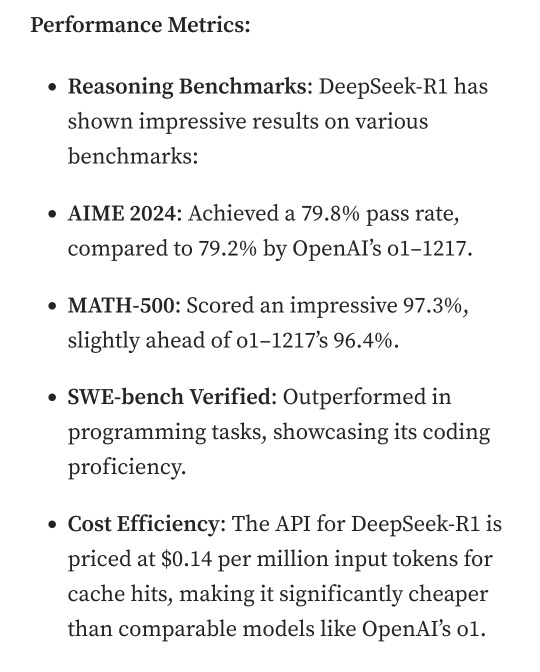
Oh, I would not want to be an OpenAI investor right now either. A token is basically one Unicode character (it's more complicated than that but you can google that on your own time). That cost means you could input the entire works of Stephen King for under a dollar. Yes, including electricity costs. DeepSeek has jumped from a Ford T to a Subaru in terms of pollution and water use.
The issue here is not only input cost, though; all that data needs to be available live, in the RAM; this is why you need powerful, expensive chips in order to-

Holy shit.
I'm not going to detail all the numbers but I'm going to focus on the chip required: an RTX 3090. This is a gaming GPU that came out as the top of the line, the stuff South Korean LoL players buy…
Or they did, in September 2020. We're currently two generations ahead, on the RTX 5090.
What this is telling all those people who just sold their high-end gaming rig to be able to afford a machine that can run the latest ChatGPT locally, is that the person who bought it from them can run something basically just as powerful on their old one.
Which means that all those GPUs and NPUs that are being made, and all those deals Microsoft signed to have control of the AI market, have just lost a lot of their pulling power.
Well, I mean, the ChatGPT subscription is 20 bucks a month, surely the Chinese are charging a fortune for-
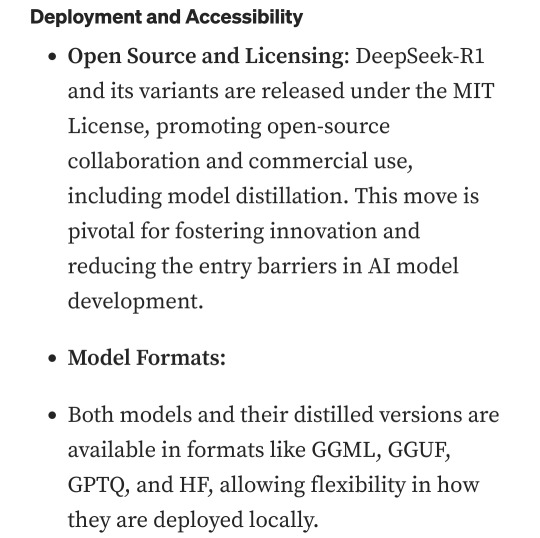
Oh. So it's free for everyone and you can use it or modify it however you want, no subscription, no unpayable electric bill, no handing Microsoft all of your private data, you can just run it on a relatively inexpensive PC. You could probably even run it on a phone in a couple years.
Oh, if only China had massive phone manufacturers that have a foot in the market everywhere except the US because the president had a tantrum eight years ago.
So… yeah, China just destabilised the global economy with a torrent file.
#valid ai criticism#ai#llms#DeepSeek#ai bubble#ChatGPT#google gemini#claude ai#this is gonna be the dotcom bubble again#hope you don't have stock on anything tech related#computer literacy#tech literacy
433 notes
·
View notes
Text

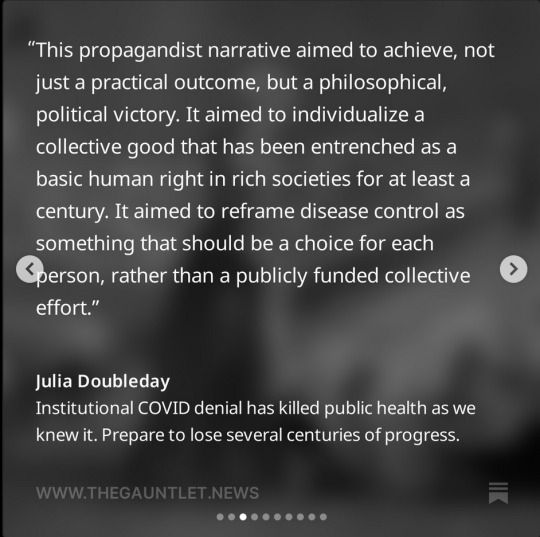






id below the cut
source
screenshots from Instagram user gauntletnews containing several article snippets:
Institutional COVID denial has killed public health as we knew it. Prepare to lose several centuries of progress.
This propagandist narrative aimed to achieve, not just a practical outcome, but a philosophical, political victory. It aimed to individualize a collective good that has been entrenched as a basic human right in rich societies for at least a century. It aimed to reframe disease control as something that should be a choice for each person, rather than a publicly funded collective effort.
...
demanding clean air and clean water is not “living in fear” but simply expecting the bare minimum of a democratic society to which we pay taxes and refusing to be a bootlicker for billionaire talking points.)
...
The history of public health in this country and around the world is the history of disease eradication, mitigation, suppression, and prevention. The name of the public health body currently pushing “you do you” as a strategy is the Center for Disease Control and Prevention, for God’s sake. It’s not the Center for Diseases Are Fine and Go About Your Day.
...
Let’s talk about the short and long-term social outcomes of COVID normalization. Yes, masks and all other precautions are demonized to the point of being framed as indicative of mental illness, including on the left. But we also see this attitude bleeding into disease control generally. Another reason the public appears more willing- perhaps even eager- to spread disease- has to do with officially sanctioned misinformation being hurled at parents: that your kids are getting sick more often because of the “lockdowns” that occurred in 2020.
...
Unless we change course urgently- unless we fight back against the normalization of constant illness and the individualization of a critical public good- we are going to see a long, slow, across-the-board decline in health and life expectancy amid increasingly uncontrollable disease outbreaks and overwhelmed hospital systems.
...
The reality is that our kids will be continually reinfected with COVID while navigating the return of measles and other vaccine-controlled diseases, while being told there is zero technology that can protect them and zero reason to protect them, while contracting flu and RSV more frequently and with worse severity.
...
This is not 1824. It is 2024. We have the technology and knowledge to mitigate disease spread. Let’s fight for a future that is safer, better, and healthier than the world we grew up in, rather than sicker, crueler, and technologically regressed. If we don’t face reality and understand what we’re sacrificing right now, the next generation certainly will.
end id]
#covid#disability justice#human rights#healthcare#do the people ''protecting the children'' keep masks out of their kids' hands? ... yeah
681 notes
·
View notes